Fishhook Removal
1. Retrograde Technique
Is the simplest of the removal techniques, but has the lowest success rate.
Works well for barbless and superficially embedded hooks.
Step 1: Apply downward pressure to the shank of the hook
This maneuver helps rotate the hook deeper and disengage the barb, if present, from the tissue.
Any resistance or catching of the barb during the procedure should alert the practitioner to stop and consider other removal methods
Step 2: Back the hook out of the skin along the path of entry
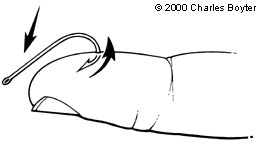
2. String-yank Technique
Modification of the retrograde technique. Commonly performed in the field and is thought to be less traumatic because it creates no new wounds and rarely requires anesthesia.
May be used to remove any size fishhook, but usually works best when removing small and medium size fishhooks.
This technique also works well for deeply embedded fishhooks, but cannot be executed on parts of the body that are not fixed (e.g., earlobe).
Step 1: Wrap a string, such as fishing line or suture material, around the midpoint of the bend in the fishhook with the free ends of the string held tightly
Step 2: Stabilize the involved skin area against a flat surface as the shank of the fishhook is depressed against the skin
Step 3: Depress the eye and/or distal portion of the shank of the hook, taking care to keep the shank parallel to the underlying skin
Step 4: Apply a firm, quick jerk parallel to the shank while continuing to exert pressure on the eye of the fishhook
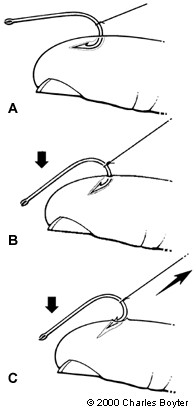
(A) Wrap a string around the midpoint of the bend in the fishhook. (B) Depress the shank of the fishhook against the skin. (C) Firmly and quickly pull on the string while continuing to apply pressure to the shank.
3. Needle Cover Technique
Step 1: Cleanse and anesthetize affected area
Step 2: Advance an 18-gauge or larger needle along the entrance wound of the fishhook
Step 3: Advance the fishhook to disengage the barb, then pull and twist it so that the point enters the lumen of the needle
Step 4: Back out the fishhook (the same way as in the retrograde technique), taking care to move the needle along the track with the fishhook
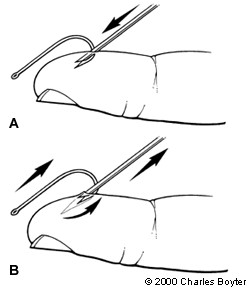
(A) Advance an 18-gauge or larger-gauge needle along the fishhook until the needle opening covers the point. (B) The fishhook and needle are then removed at the same time.
4. Advance and Cut Technique
This method is most effective when the point of the fishhook is located near the surface of the skin.
It involves two methods of removal: (i) single-point fishhooks (Figure 1) and (ii) multiple-barbed fishhooks (Figure 2).
(i) Single-point fishhooks
Step 1: Cleanse and anesthetize affected area
Step 2: Use pliers or needle driver to advance the point of the fishhook (including the entire barb) through the skin
Step 3: Cut off the point and barb with pliers or another cutting tool and back out the fishhook
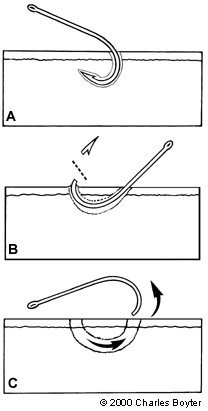
(A) The fishhook is advanced through the skin. (B)The barb is then cut off and (C) the remaining hook is backed out through the entry wound.
(ii) Multiple-barbed fishhooks
Step 1: Cleanse and anesthetize affected area
Step 2: Advance the fishhook
Step 3: Cut off the eye of the fishhook
Step 4: Pull the fishhook in the same direction as the point was advanced
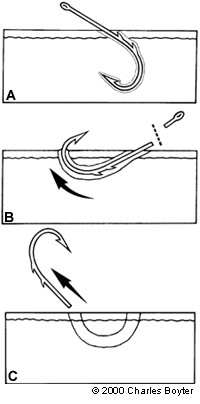
(A) The fishhook is advanced through the skin. (B) The eye of the fishhook is then cut off and (C) the remaining portion of the fishhook is pulled through the exit wound created by advancing the point.

